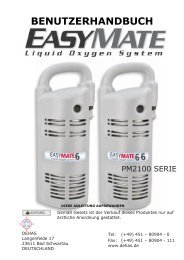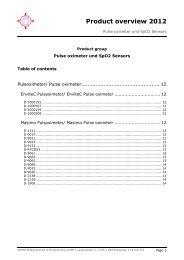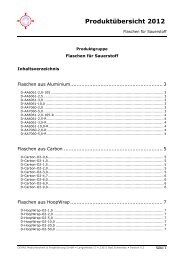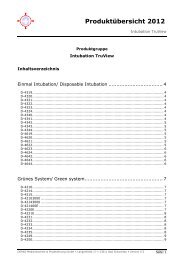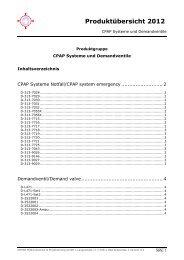Technical Service Manual PM2300 Series Liquid Oxygen Reservoir
Technical Service Manual PM2300 Series Liquid Oxygen Reservoir
Technical Service Manual PM2300 Series Liquid Oxygen Reservoir
You also want an ePaper? Increase the reach of your titles
YUMPU automatically turns print PDFs into web optimized ePapers that Google loves.
WARNING<br />
Extreme cold hazard. <strong>Liquid</strong> oxygen discharge from the fill connector can occur. When<br />
disconnecting the transfer line, never stand directly over the EasyMate <strong>Reservoir</strong> fill connector.<br />
If the EasyMate <strong>Reservoir</strong> fill connector stays open and minor liquid oxygen discharge occurs,<br />
carefully engage and disengage the transfer line to help dislodge any ice or other obstruction.<br />
If major liquid oxygen discharge (steady stream) occurs, open the VTF Valve (if safely possible)<br />
to vent pressure and stop the release of liquid oxygen. Open windows and doors to ventilate the<br />
room and do not walk on areas exposed to liquid oxygen for 60 minutes after frost disappears.<br />
5.4.11 When you observe the first steady discharge (greater than 1 second) of liquid oxygen from<br />
the VTF Valve, close the VTF Valve and disconnect the transfer line from the EasyMate<br />
<strong>Reservoir</strong> by lifting the fill adapter straight up. If the transfer line will not disengage close<br />
the liquid valve on the source tank and allow the transfer line and fill connectors to thaw.<br />
CAUTION<br />
If the VTF Valve freezes in the open position, terminate the fill by disconnecting the transfer line<br />
and then allow the VTF Valve to warm until it closes easily. If the VTF Valve remains open for a<br />
period of time, the liquid oxygen in the unit will desaturate to a pressure lower than required.<br />
5.4.12 Close the source tank liquid valve when the frost melts from the transfer line assembly.<br />
5.4.13 Replace the fill connector cover, if present, on the EasyMate <strong>Reservoir</strong>. Close the source<br />
tank liquid valve when the frost melts from the transfer line assembly.<br />
5.5 Post-Fill Inspection<br />
Perform the following procedure to inspect the EasyMate <strong>Reservoir</strong> and determine its operational<br />
status after filling it with liquid oxygen. Correct observed problems before placing the unit in service.<br />
5.5.1 Verify that the EasyMate <strong>Reservoir</strong> fill connector is closed and not leaking.<br />
5.5.2 Verify that the VTF Valve is completely closed and not leaking.<br />
5.5.3 Verify that the fill pressure gauge attached to the EasyMate <strong>Reservoir</strong> <strong>Oxygen</strong> Outlet Fitting<br />
reads at least 20 psig (1.38 bar) within five minutes after terminating the fill.<br />
5.5.4 Verify that there is no frost or heavy condensation on the container below the shroud.<br />
5.5.5 Verify that all lights are illuminated when the contents indicator button is activated.<br />
5.5.6 Disconnect the pressure gauge from the EasyMate <strong>Reservoir</strong> <strong>Oxygen</strong> Outlet Fitting.<br />
5.6 Checking Saturation Pressure<br />
Perform the following procedure as needed to determine the saturation pressure of the liquid<br />
oxygen in the EasyMate <strong>Reservoir</strong> unit.<br />
5.6.1 Attach a 0 – 30 psig (0 – 2.07 bar) fill pressure gauge (P/N 505648 or equivalent) to the<br />
EasyMate <strong>Reservoir</strong> <strong>Oxygen</strong> Outlet Fitting. Note the pressure indicated on the gauge.<br />
5.6.2 Momentarily open the VTF Valve on the EasyMate <strong>Reservoir</strong> and observe the pressure<br />
gauge pointer as it drops.<br />
5.6.3 Note the pressure value where the gauge pointer drops the lowest and then close the VTF Valve.<br />
This is the approximate saturation pressure of the EasyMate <strong>Reservoir</strong>. Saturation pressure readings<br />
between 18 and 23 psig (1.24 – 1.59 bar) are in the acceptable pressure range.<br />
DANGER<br />
Explosive hazard. Extreme high pressure can rupture a transfer line. Make sure the<br />
specified pressure relief valve is present, in the proper location, and functioning properly on<br />
the transfer line assembly.<br />
<strong>PM2300</strong> <strong>Series</strong> <strong>Liquid</strong> <strong>Oxygen</strong> <strong>Reservoir</strong><br />
<strong>Technical</strong> <strong>Service</strong> <strong>Manual</strong><br />
11



